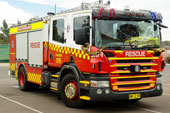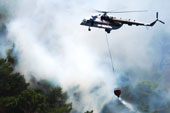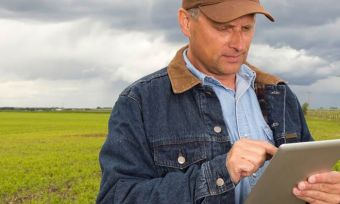With the weather bureau predicting a severe disaster season ahead, the Federal Government has committed to fund disaster resilience projects to protect communities across the country.
Federal Government commits to funding resilience before disaster season hits
The Insurance Council of Australia (ICA) has launched a national campaign warning households and businesses that we are due for a severe disaster season from November to April. With risk levels soaring for cyclones, storms, floods, and bushfires, the Federal Government has committed funding to build resilience in communities across Australia before this year’s extreme weather hits.
“It’s shaping up to be a severe summer of natural disasters, and insurers and emergency services organisations across Australia are concerned many households and businesses are not prepared.
Last disaster season brought insured losses of more than $630 million – and that was considered fairly benign.
Australians must not underestimate the damage a severe season could wreak.”
(ICA CEO Rob Whelan)
An above-average cyclone season has been forecast by the weather bureau, especially for communities in North Queensland, Darwin (NT), and the Pilbara (NT). At the other extreme, a heightened risk of bushfires is predicted across much of southern Australia, especially in NSW, Victoria, and WA (Bushfire and Natural Hazards Cooperative Research Centre).
As of the International Day for Disaster Risk Reduction (13 October 2016), the Federal Government has committed to spending the following in its disaster mitigation and resilience plan:
 |
Natural Disaster Resilience Program (joint funding with states and territories) for disaster resilience initiatives | $52 million over 2 years starting from 2015-16 |
 |
National Bushfire Mitigation Program | $15 million provided to states and territories over 3 years starting from 2014-15 |
 |
National aerial fire-fighting capability (NAFC) | $14 million per year |
 |
National Emergency Management Projects grants program to deliver nationally significant disaster resilience projects | Approximately $3.6 million per year |
Australia has also recently ratified the Paris Agreement following the 22nd UN Climate Change Conference, as we know that climate change affects natural disasters and therefore the cost of home insurance.
How you can prepare for disaster season
Check the CANSTAR disaster preparation and survival checklists for information from BOM and other organisations on how to plan for resilience this disaster season:
Insurance Disaster resilience in Victoria
Victoria will benefit from an $850,000 boost to funding for bushfire mitigation projects.
The Victorian Government is focussing on reducing and fighting environmental risk factors, such as water supply and fuel management on properties; and ensuring communities are aware of how they can build disaster resilience against bushfires, with construction of fire breaks and fire drill programs.
Projects to be funded in 2016-17 in Victoria include:
- Construction of fire breaks and fire access tracks around rural townships and cities
- Water supply security improvements
- Fuel management activities
- Programs to test and improve fire readiness
- Arson prevention program
$150,000 will be provided to Victoria to buy and install 10 more automatic fire danger rating signs to warn locals as fire danger escalates.
For a full list of 2016-17 programs and grant recipients, visit the Emergency Management Victoria website.
Source: Queensland Farmers Federation
Disaster resilience in NSW
New South Wales has announced $27 million in funding for disaster resilience in local communities, including $13.6 million worth of Federal Commonwealth funding.
This funding will be used through the continuation of existing funding programs such as the Community Resilience Innovation Program (CRIP), Emergency Volunteer Support Scheme (EVSS), bushfire and floodplain grants schemes, and State Emergency Management Projects.
Minister for Justice, Michael Keenan, said, “These programmes, led by state agencies, local councils, non-government organisations, volunteer organisations, and researchers, are all designed to help communities step up [their] efforts to manage and respond to natural disaster risks.”
NSW Minister for Justice and Police, Troy Grant, said these partnerships between government, non-government organisations, and the community help to build a culture of shared responsibility for disaster resilience.
Disaster resilience in Queensland
Queensland communities will benefit from $25.7 million in funding for 85 projects to boost natural disaster resilience.
Queensland Assistant Minister for Local Government and Infrastructure, Glenn Butcher, says, “The financial cost of natural disasters is greater in Queensland than any other Australian state or territory, and the NDRP [funding] will allow us to focus on efforts to achieve the maximum benefit towards state-wide natural disaster resilience priorities.”
That natural disasters cost more in Queensland is evident in the cost of our home and contents insurance premiums, particularly in North Queensland.
On 8 November 2016, it was announced that more than $200,000 of that funding will be provided in fast-tracked grants to three local councils in Queensland to improve their regions prepare for, respond to, and recover from natural disasters. This amount is in addition to the $1.2 million already provided by the Federal Government to Queensland for resilience projects in October 2016.
The $200,000 of fast-tracked grants offer up to 60% funding for the total eligible costs of most disaster resilience projects.
“Expediting this funding means that work on these essential projects can begin as soon as possible,” explained Queensland Deputy Premier and Minister for Infrastructure, Local Government and Planning, Jackie Trad.
Projects included in funding for 2016-17 in Queensland include:
- Tablelands Regional Council – catchment-wide flood mitigation study to investigate the most effective way to prevent stormwater flooding in the Atherton commercial centre
- Croydon Shire Council – projects for improvement of disaster resilience
- McKinlay Shire Council – projects for improvement of disaster resilience
For more information on Queensland grants and subsidies for disaster resilience, visit the Department of Infrastructure, Local Government and Planning website.
As of 2016, there is also a new website to help farmers navigate disaster support, created by the Queensland Farmers’ Federation and funded by the Queensland Government: farmerdisastersupport.org.au
Resilience funding for Rockhampton, QLD
Rockhampton has received funding of $1.77 million for two local community disaster resilience projects. The Rockhampton Regional Council estimates these two projects alone will support 32 local jobs during construction and 4 ongoing local jobs.
$900,000 will go towards an upgrade of Stanwell-Waroula Road, making it more resilient to future flooding and making it safer for travellers and locals.
A further $870,000 is funding an upgrade of the concrete floodway on Nine Mile Road, making this important connecting road safer and more resilient to future floods.
Resilience funding for Bundaberg, QLD
Bundaberg has received $600,000 worth of funding for four community resilience projects in the region.
Queensland Assistant Minister for Local Government and Infrastructure Glenn Butcher explained, “We’ve seen that the Bundaberg region is vulnerable to flooding, so these projects are vital to improve the community’s resilience.”
Projects being funded in 2016-17 in the Bundaberg region include:
- Branyan Drive culvert upgrade to improve flood evacuation route: $181,560
- Flood-resilient river gauge at Walla and three additional areas in the region: $42,000
- Education to improve resilience knowledge and SES capability in Childers and Bundaberg: $39,000
- Windemere Road culvert upgrade to improve emergency access to areas of Bargara and Innes Park: $327,600
Resilience funding for Livingstone, QLD
Livingstone Shire Council has received funding of more than $3.83 million for the Livingstone Shire Council for three community disaster resilience projects.
Queensland Assistant Minister for Local Government and Infrastructure Glenn Butcher stated, “Having seen the destruction caused so recently by Cyclone Marcia, it is clear that the Livingstone region is vulnerable to natural disasters – so these projects are vital to improve the community’s resilience.”
Projects being funded in 2016-17 in Livingstone include:
- Local Disaster Coordination Centre and Community Resilience Engagement Hub (multi-purpose disaster coordination headquarters, evacuation centre, and venue for community disaster preparation education): $3.35 million
- Flood mitigation project to improve flow under Appleton Drive bridge: $ 449,460
- Developing a community engagement program and mapping the at-risk communities affected by storm surges and tsunami: $30,000
Source: Queensland Farmers Federation
Disaster resilience in Western Australia
Western Australia’s bushfire mitigation projects have been allocated up to $300,000 funding to prepare communities for bushfires across the state. This funding is on top of $600,000 already provided to WA under the Federal Government’s $15 million National Bushfire Mitigation Programme (see above).
This funding will be distributed in grants to 16 projects in WA in 2016-17, including:
- Upgrading and maintaining fire trails and fire breaks
- Reducing fuel loads in high risk bushfire-prone areas
- Upgrading infrastructure to build community resilience
“Local bushfire risks need local solutions, which is why we welcome the Commonwealth’s support to fund these initiatives and help our high bushfire risk communities be better prepared,” says Western Australian Minister for Emergency Services, Fisheries, Corrective Services and Veterans Joe Francis.
For more information regarding the 16 projects, visit the Western Australia Department of Fire and Emergency Services website.
Source: Queensland Farmers Federation
Insurance Disaster resilience in Northern Territory
The Northern Territory has announced $7.1 million in funding, which includes $2.6 million of Federal Commonwealth funding for resilience activities both in local areas and territory-wide.
Projects to be funded in 2016-17 in NT include:
- Cyclone shelter to be built for Ramingining community at local school: $4.5 million worth of territory funding
- Disaster Resilience Fund (DRF)
- Disaster Resilience Emergency Volunteer Fund (DREVF) to support disaster resilience volunteers
- Territory Risk Priority Project Fund (TRPPF)
- Raising community awareness on natural disaster risks
- Developing strategies to increase the capability of emergency responders
Applications for project funding are now open and will close on midnight of Sunday, 8 January 2016. For more information or to apply, visit the Northern Territory Emergency Service website.


 “It’s shaping up to be a severe summer of natural disasters, and insurers and emergency services organisations across Australia are concerned many households and businesses are not prepared.
“It’s shaping up to be a severe summer of natural disasters, and insurers and emergency services organisations across Australia are concerned many households and businesses are not prepared.




Share this article